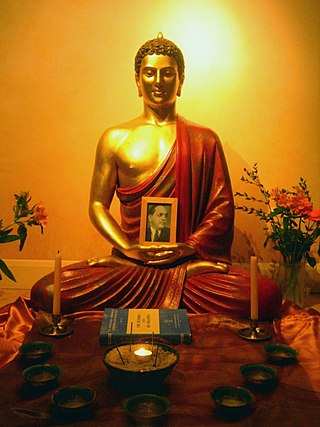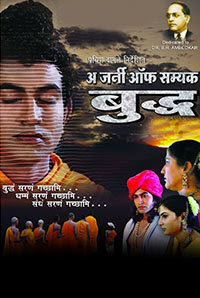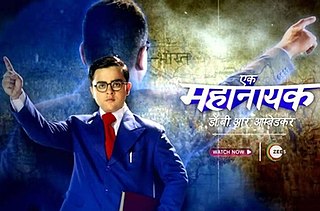Related Research Articles

Bhimrao Ramji Ambedkar was an Indian jurist, economist, social reformer and political leader who headed the committee drafting the Constitution of India from the Constituent Assembly debates, served as Law and Justice minister in the first cabinet of Jawaharlal Nehru, and inspired the Dalit Buddhist movement after renouncing Hinduism.

The Dalit Buddhist movement is a religious as well as a socio-political movement among Dalits in India which was started by B. R. Ambedkar. It re-interpreted Buddhism and created a new school of Buddhism called Navayana. The movement has sought to be a socially and politically engaged form of Buddhism.
Engaged Buddhism, also known as socially engaged Buddhism, refers to a Buddhist social movement that emerged in Asia in the 20th century. It is composed of Buddhists who seek to apply Buddhist ethics, insights acquired from meditation practice, and the teachings of the Buddhist dharma to contemporary situations of social, political, environmental, and economic suffering, and injustice.

Deekshabhoomi, also written as Deeksha Bhoomi, is a sacred monument of Navayana Buddhism located in Nagpur city in the state of Maharashtra in India; where B. R. Ambedkar with approximately 400,000 of his followers, mainly Dalits, embraced Buddhism on Ashoka Vijaya Dashami on 14 October 1956. Ambedkar played a significant role in the revival of Buddhism in India, and inspired many such mass conversions to Buddhism.

Buddhism is an ancient Indian religion, which arose in and around the ancient Kingdom of Magadha. It is based on the teachings of Gautama Buddha, who lived in the 6th or 5th century BCE and was deemed a "Buddha". However, Buddhist doctrine holds that there were other Buddhas before him. Buddhism spread outside of Magadha starting in the Buddha's lifetime.

Navayāna, otherwise known as Navayāna Buddhism, refers to the modern re-interpretation of Buddhism founded and developed by the Indian jurist, social reformer, and scholar B. R. Ambedkar; it is otherwise called Neo-Buddhism and Ambedkarite Buddhism.
Bhadant Anand Kausalyayan was an Indian Buddhist monk, scholar, traveller and a prolific writer. He is considered one of the great activists of Buddhism of the 20th century. He was influenced by the Buddhist scholar and social reformer Rahul Sankrityayan and B. R. Ambedkar.
Buddhist modernism are new movements based on modern era reinterpretations of Buddhism. David McMahan states that modernism in Buddhism is similar to those found in other religions. The sources of influences have variously been an engagement of Buddhist communities and teachers with the new cultures and methodologies such as "Western monotheism; rationalism and scientific naturalism; and Romantic expressivism". The influence of monotheism has been the internalization of Buddhist gods to make it acceptable in modern Western society, while scientific naturalism and romanticism has influenced the emphasis on current life, empirical defense, reason, psychological and health benefits.

A Journey of Samyak Buddha is a 2013 Indian film about the journey of Gautam Buddha’s miraculous birth, marriage, and his path towards enlightenment. The biographical film is based on Babasaheb Ambedkar's book The Buddha and His Dhamma.

Chaitya Bhoomi, also written as Chaityabhoomi, is a Buddhist chaitya and the cremation place of B. R. Ambedkar, the architect of the Indian Constitution and the revived Buddhism in India. It is situated besides Dadar Chowpatty (beach), Mumbai, Maharashtra, India. Chaitya Bhoomi is a revered place of pilgrimage for Ambedkar's followers, who visit in millions annually on his death anniversary on 6 December.

Dr Savita Bhimrao Ambedkar, was an Indian social activist, doctor and the second wife of B.R. Ambedkar.

Marathi Buddhists are Buddhists of Marathi ethnic and linguistic identity. The religious community resides in the Indian state of Maharashtra. They speak Marathi as their mother-tongue. The Marathi Buddhist community is the largest Buddhist community in India. According to the 2011 Indian census, Marathi Buddhists constitute 5.81% of the population in Maharashtra, which is 77% of the total Buddhist population in India.

Lord Buddha TV is an Indian 24×7 Hindi and Marathi mainstream Ambedkarite and Navayana Buddhist channel with focus on Bahujan issues. It is headquartered in Nagpur, Maharashtra. In June 2018, its viewership was 25 million. It broadcasts daily programmes and documentaries on Buddha's teachings and his Dhamma. The Lord Buddha TV is available on more than 800 cable operators, DTH platforms as well as online.

Bhim Janmabhoomi is a memorial dedicated to Bhimrao Ambedkar, located at Mhow in Madhya Pradesh, India. This was birthplace of Ambedkar, who was born on 14 April 1891 in Mhow. where the local government built this grand memorial. This memorial was inaugurated on Ambedkar's 100th birth anniversary – 14 April 1991 by the then Chief Minister of Madhya Pradesh, Sunder Lal Patwa. The architecture of the memorial was composed by architect E.D. Nimgade. Later, On 14 April 2008, the 117th birthday of Ambedkar, inaugurated the memorial. Nearly 4.52 acres of land is connected to the memorial.
The relationship between Buddhism and democracy has a long history with some scholars claiming the very foundations of Buddhist society were democratic. Though some historic Buddhist societies have been categorized as feudalistic, the relationship between peasants and land owners was often voluntary. Free-thinking Buddhist societies supported autonomy; peasants had mobility and could own land themselves. Currently countries claiming democracy with Buddhist state religions are Bhutan, Cambodia, Myanmar, and Sri Lanka.
Baudhacharya Shanti Swaroop Baudh was an Indian writer, Buddhist scholar, painter, publisher and Pali language expert. He was an Ambedkarite-Buddhist activist. He was born in 1949 at Old Delhi in a Jatav Dalit family. In 1975, he set up Samyak Prakashan, a publishing house dedicated to Ambedkarite, Navayana Buddhist, Pali literature and Dalit literature. Samyak Prakashan has published over 2000 books many of which have been translated into some 14 different languages including English, Sinhalese, Nepalese, Burmese. He was a board of editors member of Dhamma Darpan and Dalit Dastak magazines. He was Delhi state president of Buddhist Society of India.

The Twenty-two vows or twenty-two pledges are the 22 Buddhist vows administered by B. R. Ambedkar, the revivalist of Buddhism in India, to his followers. On converting to Buddhism, Ambedkar made 22 vows, and asked his 400,000 supporters to do the same. After receiving lay ordination, Ambedkar gave dhamma diksha to his followers. This ceremony organised on 14 October 1956 in Nagpur included 22 vows administered to all new converts after Three Jewels and Five Precepts. On 16 October 1956, Ambedkar performed another mass religious conversion ceremony at Chandrapur.

Ek Mahanayak – Dr. B.R. Ambedkar(Translation: A Great Hero – Dr. B.R. Ambedkar) is an Indian Hindi-language drama series produced by Sobo Films. It premiered on 17 December 2019 on And TV with Ayudh Bhanushali as the five-year old Bhimrao. In 2021, the story moved on for several years and Atharva Karve was introduced as young B. R. Ambedkar.
References
- ↑ Ambedkar, B. R. The Buddha and His Dhamma, retrieved 2008-12-27
- 1 2 Queen, Christopher (2015). Emmanuel, Steven M. (ed.). A Companion to Buddhist Philosophy. John Wiley & Sons. pp. 529–531. ISBN 978-1-119-14466-3.
- ↑ Ambedkar, Babasheb, Dr. (1979) [1957]. The Buddha and His Dhamma (PDF).
{{cite book}}: CS1 maint: multiple names: authors list (link) - ↑ Ambedkar, B.R. "Preface / unpublished". Columbia University.
- ↑ "Film on Buddha based on Ambedkar's book to be released on March 15". The Times of India . 13 March 2013. Archived from the original on 15 November 2013. Retrieved 19 July 2013.